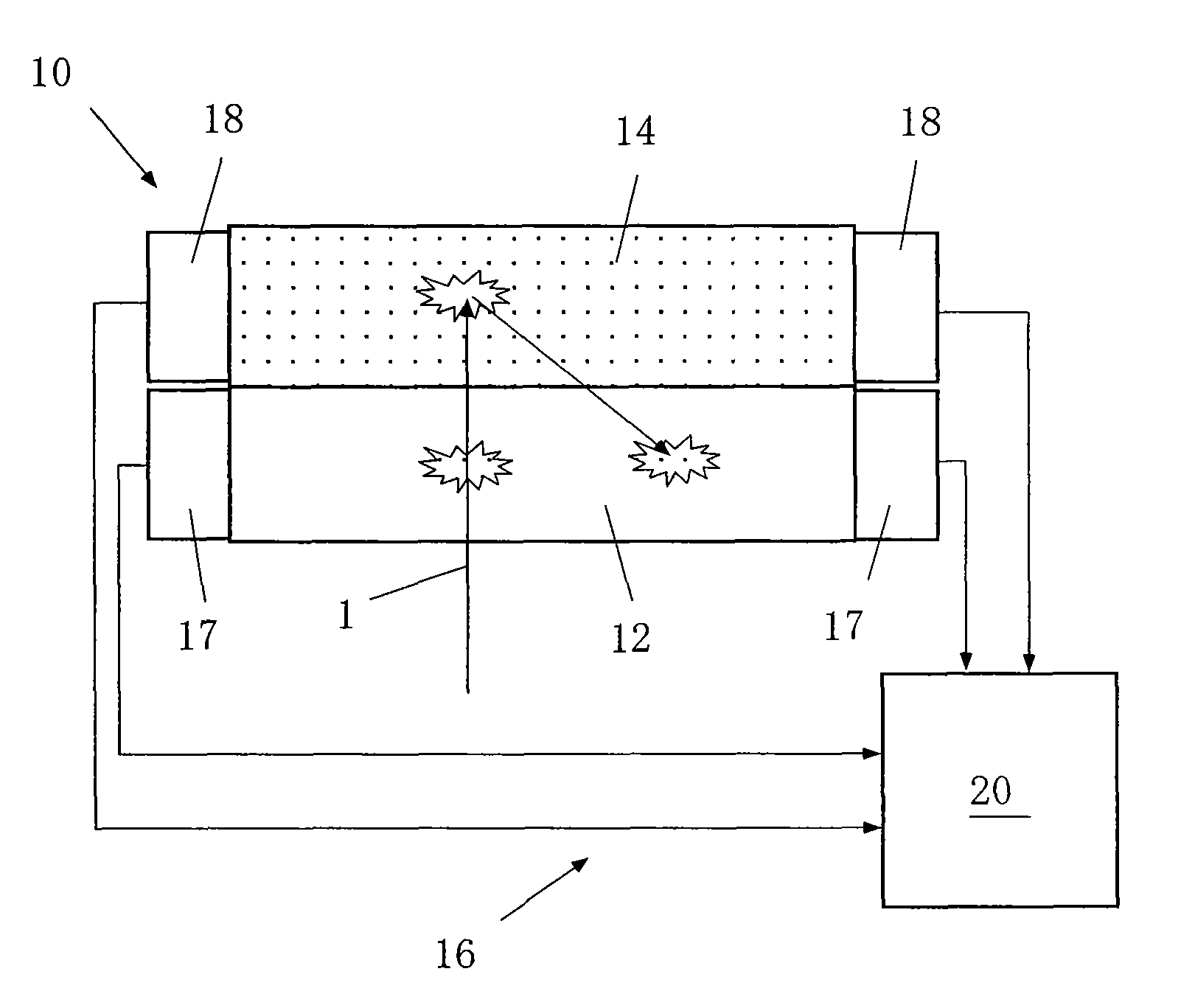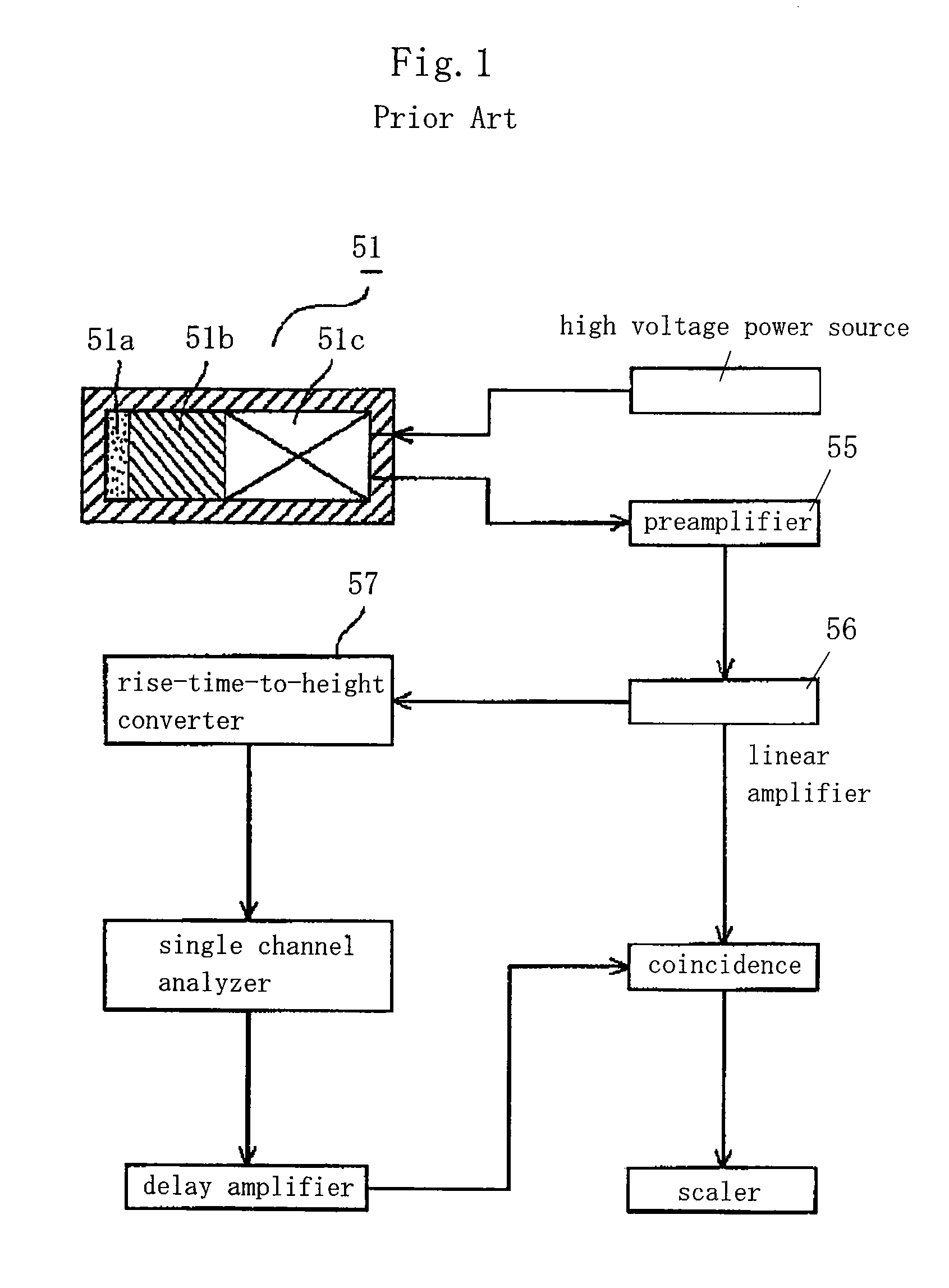Beta ray detector and beta ray reconstruction method
a detector and beta ray technology, applied in the field of radiation detectors, can solve the problems of abrupt decrease in detection efficiency, low energy resolution compared to inorganic scintillators, and affecting the detection efficiency of radiation, so as to increase the beta ray detection efficiency, improve the detection efficiency, and improve the effect of energy resolution
- Summary
- Abstract
- Description
- Claims
- Application Information
AI Technical Summary
Benefits of technology
Problems solved by technology
Method used
Image
Examples
first embodiment
[0068]FIG. 5 is a configuration diagram illustrating a beta ray detector of the present invention.
[0069]In the drawing, a beta ray detector 10 according to the present invention is equipped with an absorber scintillator 12, a backscattering scintillator 14, and an energy detector 16.
[0070]The absorber scintillator 12 is disposed to face a subject (for example, a human body, a clothes, equipments, and the like; not illustrated) emitting beta rays 1 and is made from an absorptive substance exhibiting a high permeability and a high rate of absorption with respect to the beta rays 1. The energy region of the beta rays 1 is about 0.5 to 3 MeV, for example.
[0071]The absorptive substance exhibiting a high permeability and a high rate of absorption with respect to beta rays is an organic material, for example, and particularly preferably is an organic material having a small mass number, consisting of carbon and hydrogen molecules. A plastic scintillator or p-terphenyl is an example of the ...
second embodiment
[0128]FIG. 9 is a configuration diagram illustrating the beta ray detector of the present invention.
[0129]The exact incident positions of beta rays (fluorescence occurrence position) can be determined by the above-described fluorescence position analysis method. However, the fluorescence position analysis method cannot detect the incoming direction (the direction) of beta rays.
[0130]Therefore, in the second embodiment illustrated in FIG. 9, the absorber scintillator 12 is formed of two or more layers (in this example, three layers) of absorptive substance, and the absorption light intensity detector 17 calculates the incident positions of beta rays 1 from the light intensity distribution of the absorptive substance of each layer of the absorber scintillator 12 to detect the incoming direction thereof.
[0131]That is to say, the absorber scintillator 12 (the fluorescent screen No. 1) used in the first embodiment is arranged in multiple layers, and the mutual positions on the respective...
third embodiment
[0134]FIG. 10 is a configuration diagram illustrating the beta ray detector of the present invention.
[0135]In this example, the absorber scintillator 12 and the backscattering scintillator 14 are respectively provided on both surfaces of a flat board-like subject 4 emitting beta rays. In this drawing, the illustration of the energy detector 16 is omitted.
[0136]A phenomenon in which two beta decays occur substantially simultaneously is known as a “double beta decay.” A double beta decay where no neutrinos are emitted is a phenomenon of which the half-life is extremely long and which occurs once in about 1026 years. However, research is being conducted in various countries because observation of this decay can define or explain the neutrino mass, the Majorana particle, the CP Phase, and the like.
[0137]To measure this phenomenon, it is important to accurately measure two beta rays resulting from double beta decay. The beta ray reconstruction method of the present invention can be appli...
PUM
 Login to View More
Login to View More Abstract
Description
Claims
Application Information
 Login to View More
Login to View More - R&D
- Intellectual Property
- Life Sciences
- Materials
- Tech Scout
- Unparalleled Data Quality
- Higher Quality Content
- 60% Fewer Hallucinations
Browse by: Latest US Patents, China's latest patents, Technical Efficacy Thesaurus, Application Domain, Technology Topic, Popular Technical Reports.
© 2025 PatSnap. All rights reserved.Legal|Privacy policy|Modern Slavery Act Transparency Statement|Sitemap|About US| Contact US: help@patsnap.com



